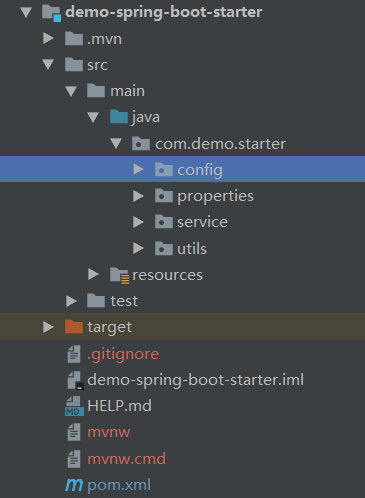码前必备知识
SpringBoot starter机制
SpringBoot中的starter是一种非常重要的机制,能够抛弃以前繁杂的配置,将其统一集成进starter,应用者只需要在maven中引入starter依赖,SpringBoot就能自动扫描到要加载的信息并启动相应的默认配置。starter让我们摆脱了各种依赖库的处理,需要配置各种信息的困扰。SpringBoot会自动通过classpath路径下的类发现需要的Bean,并注册进IOC容器。SpringBoot提供了针对日常企业应用研发各种场景的spring-boot-starter依赖模块。所有这些依赖模块都遵循着约定成俗的默认配置,并允许我们调整这些配置,即遵循“约定大于配置”的理念
为什么要自定义starter
在我们的日常开发工作中,经常会有一些独立于业务之外的配置模块,我们经常将其放到一个特定的包下,然后如果另一个工程需要复用这块功能的时候,需要将代码硬拷贝到另一个工程,重新集成一遍,麻烦至极。如果我们将这些可独立于业务代码之外的功配置模块封装成一个个starter,复用的时候只需要将其在pom中引用依赖即可,SpringBoot为我们完成自动装配,简直不要太爽
自定义starter的案例
以下案例由笔者工作中遇到的部分场景
- 动态数据源
- 登录模块
- 基于AOP技术实现日志切面
。。。
自定义starter的命名规则
SpringBoot提供的starter以spring-boot-starter-xxx的方式命名的。官方建议自定义的starter使用xxx-spring-boot-starter命名规则。以区分SpringBoot生态提供的starter
starter的实现方法
新建一个工程
命名为demo-spring-boot-starter
下图为工程目录结构

pom依赖
<?xml version="1.0" encoding="UTF-8"?>
<project xmlns="http://maven.apache.org/POM/4.0.0" xmlns:xsi="http://www.w3.org/2001/XMLSchema-instance"
xsi:schemaLocation="http://maven.apache.org/POM/4.0.0 http://maven.apache.org/xsd/maven-4.0.0.xsd">
<modelVersion>4.0.0</modelVersion>
<parent>
<groupId>org.springframework.boot</groupId>
<artifactId>spring-boot-starter-parent</artifactId>
<version>2.1.4.RELEASE</version>
</parent>
<groupId>com.demo</groupId>
<artifactId>demo-spring-boot-starter</artifactId>
<version>0.0.1-RELEASE</version>
<name>demo-spring-boot-starter</name>
<description>Demo project for Spring Boot</description>
<properties>
<java.version>1.8</java.version>
</properties>
<dependencies>
<dependency>
<groupId>org.springframework.boot</groupId>
<artifactId>spring-boot-configuration-processor</artifactId>
<optional>true</optional>
</dependency>
<dependency>
<groupId>org.springframework.boot</groupId>
<artifactId>spring-boot-starter</artifactId>
</dependency>
</dependencies>
</project>
定义一个实体类映射配置信息
@ConfigurationProperties(prefix = "demo") 它可以把相同前缀的配置信息通过配置项名称映射成实体类,比如我们这里指定 prefix = "demo" 这样,我们就能将以demo为前缀的配置项拿到了。
ps:其实这个注解很强大,它不但能映射成String或基本类型的变量。还可以映射为List,Map等数据结构
package com.demo.starter.properties;
import org.springframework.boot.context.properties.ConfigurationProperties;
/**
* 描述:配置信息 实体
*
* @Author shf
* @Date 2019/5/7 22:08
* @Version V1.0
**/
@ConfigurationProperties(prefix = "demo")
public class DemoProperties {
private String sayWhat;
private String toWho;
public String getSayWhat() {
return sayWhat;
}
public void setSayWhat(String sayWhat) {
this.sayWhat = sayWhat;
}
public String getToWho() {
return toWho;
}
public void setToWho(String toWho) {
this.toWho = toWho;
}
}
定义一个Service
package com.demo.starter.service;
/**
* 描述:随便定义一个Service
*
* @Author shf
* @Date 2019/5/7 21:59
* @Version V1.0
**/
public class DemoService {
public String sayWhat;
public String toWho;
public DemoService(String sayWhat, String toWho){
this.sayWhat = sayWhat;
this.toWho = toWho;
}
public String say(){
return this.sayWhat + "! " + toWho;
}
}
定义一个配置类
这里,我们将DemoService类定义为一个Bean,交给Ioc容器。
▲ @Configuration 注解就不多说了。
▲ @EnableConfigurationProperties 注解。该注解是用来开启对3步骤中 @ConfigurationProperties 注解配置Bean的支持。也就是@EnableConfigurationProperties注解告诉Spring Boot 能支持@ConfigurationProperties。
当然了,也可以在 @ConfigurationProperties 注解的类上添加 @Configuration 或者 @Component 注解
▲ @ConditionalOnProperty 注解控制 @Configuration 是否生效。简单来说也就是我们可以通过在yml配置文件中控制 @Configuration 注解的配置类是否生效
package com.demo.starter.config;
import com.demo.starter.properties.DemoProperties;
import com.demo.starter.service.DemoService;
import org.springframework.beans.factory.annotation.Autowired;
import org.springframework.boot.autoconfigure.condition.ConditionalOnProperty;
import org.springframework.boot.context.properties.EnableConfigurationProperties;
import org.springframework.context.annotation.Bean;
import org.springframework.context.annotation.Configuration;
/**
* 描述:配置类
*
* @Author shf
* @Date 2019/5/7 21:50
* @Version V1.0
**/
@Configuration
@EnableConfigurationProperties(DemoProperties.class)
@ConditionalOnProperty(
prefix = "demo",
name = "isopen",
havingValue = "true"
)
public class DemoConfig {
@Autowired
private DemoProperties demoProperties;
@Bean(name = "demo")
public DemoService demoService(){
return new DemoService(demoProperties.getSayWhat(), demoProperties.getToWho());
}
}
最重要的来了
如图,新建META-INF文件夹,然后创建spring.factories文件

在该文件中加入如下配置,该配置指定上步骤中定义的配置类为自动装配的配置
#-------starter自动装配---------
org.springframework.boot.autoconfigure.EnableAutoConfiguration=com.demo.starter.config.DemoConfig
测试
在demo-spring-boot-starter工程中执行mvn clean install 一个自定义的starter新鲜出炉。
新建测试工程
引入starter依赖
<dependency>
<groupId>com.demo</groupId>
<artifactId>demo-spring-boot-starter</artifactId>
<version>0.0.1-RELEASE</version>
</dependency>
配置文件
demo.isopen=true
demo.say-what=hello
demo.to-who=shf
然后写个测试类
package com.example.test.controller;
import com.demo.starter.service.DemoService;
import org.springframework.web.bind.annotation.GetMapping;
import org.springframework.web.bind.annotation.RestController;
import javax.annotation.Resource;
/**
* 描述:
*
* @Author shf
* @Description TODO
* @Date 2019/5/13 15:52
* @Version V1.0
**/
@RestController
public class DemoController {
@Resource(name = "demo")
private DemoService demoService;
@GetMapping("/say")
public String sayWhat(){
return demoService.say();
}
}
浏览器
https://img2018.cnblogs.com/blog/1635748/201905/1635748-20190514221725902-1205704283.png